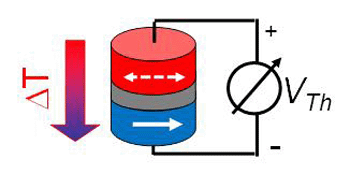Researchers Control Thermoelectric Voltages in CPU, Storage
A discovery announced by German researchers shows that heat energy dissipated by processors could be used to fuel certain processor actions or store data efficiently.
Researchers said that they found that not just the electric current, but also the thermal current flowing through magnetic tunnel structures can be monitored and controlled, simply by switching the magnetization. Such tunnel structures are often used as magnetic storage cells in MRAMs, or sensors to read data in hard disk drives. These structures consist of two magnetic layers that are separated by a 1 nm thin insulation layer. Electric current can be controlled by adjusting the resistance via the magnetic orientation of the two layers.
The scientists said that they "generated a temperature difference between the two magnetic layers" and noticed that the created electric voltage, referred to as thermoelectric voltage, also depends on the magnetic orientation of the two layers "nearly as strongly as the electric resistance." As a result, a changed magnetization also enabled them to control the thermal current flowing through the device.
If the effect can be used in a mass-produced product, future device may be able to use the energy in dissipated heat for circuit functions.
Get Tom's Hardware's best news and in-depth reviews, straight to your inbox.

Douglas Perry was a freelance writer for Tom's Hardware covering semiconductors, storage technology, quantum computing, and processor power delivery. He has authored several books and is currently an editor for The Oregonian/OregonLive.
-
cats_Paw I think everyone had this idea at least once (from the computer enthusiast comunity).Reply
I wonder if its gonna do us any good thou. -
saturnus greghomeSo...does this mean we can get silicon smaller than 4nm ?Reply
You do grasp the fundamental difference between an insulation layer thickness and distances from gate-to-gate distance on a conductive silicon, right :)
-
TeraMedia Somehow I just don't see taking up valuable silicon real-estate on a CPU to create magnet tunnels for heat transfer control. I mean, when do you not want as much heat to leave the chip as quickly as possible? And with a common substrate, the delta-T would diminish so quickly as the chip reached steady-state, that there'd be very little thermal or current flow resulting from this phenomenon.Reply
Now in situations in which you want to control heat flow for other reasons, such as to set a highly-stable, static heat flux on some type of sensor - I can see this perhaps being more useful. But I don't know what type of sensor might require such an environment. -
spiketheaardvark Practical direct conversion of heat to electricity is a bit of a physics holy grail. On this small scale I wonder if this could be adapted to form a layer a chip sits on. Heat from the chip could be "recycled" and used to supplement the power needs of the chip. This tech could do wonders for battery life if the heat put off of the chips could be put to good use.Reply
